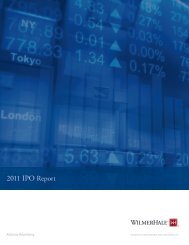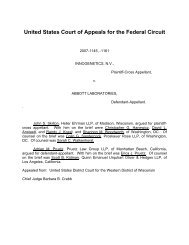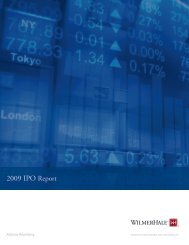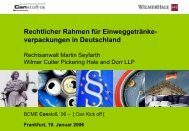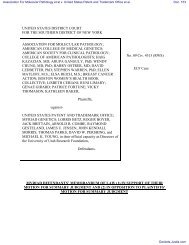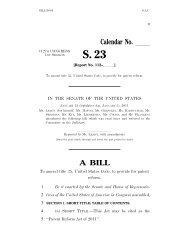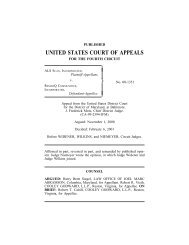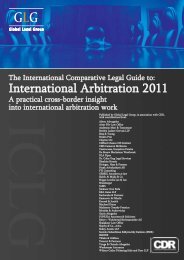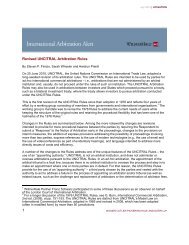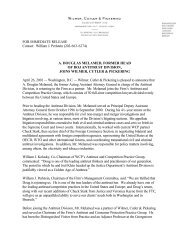14Dual Track <strong>IPO</strong>s – Pursuing Parallel Paths to LiquiditySometimes, a company (or itsinvestors) is torn between an <strong>IPO</strong>and a sale. The company may be qualifiedand willing to take on an <strong>IPO</strong>, yet enticedby the prospect of selling and unsure howto compare the relative ease and certaintyof being acquired with the equity upsideof an <strong>IPO</strong>. The choice can pose a quandaryif <strong>IPO</strong> market conditions are choppy,creating execution risk for any <strong>IPO</strong> plan.In these cases the optimum choice maybe a “dual track,” in which the companysimultaneously pursues an <strong>IPO</strong> whileentertaining—or even courting—suitors.Anecdotal evidence suggests dual trackefforts are increasing in frequency, as theperceived burdens of public company lifehave increased and <strong>IPO</strong>s have becomemore difficult to complete. A dual trackstrategy presents various challenges:■Importance of Confidentiality: Evenmore so than usual, the M&A processmust be kept under wraps, to minimizethe risk of premature disclosureand to avoid disruption to the effortand focus demanded of the <strong>IPO</strong> process.■Disclosure Issues: Absent a leak,the sale process usually need not bepublicly disclosed prior to an acquisitionannouncement. A dual track strategycan, however, result in thorny disclosureissues if the company opts for an <strong>IPO</strong>rather than a sale. For example, ifan acquisition deal is reached and thenfalls apart, the company must considerwhether the reasons for the busteddeal must be disclosed in the <strong>IPO</strong>prospectus—this could prompt negativedisclosures and delay an <strong>IPO</strong> whilethe prospectus is supplemented.■Legal Advisor: The company willalmost certainly utilize its <strong>IPO</strong> lawfirm for the M&A track as well—to usedifferent counsel for the two tracks wouldsquander the hard-earned institutionalknowledge from the <strong>IPO</strong> process andcreate logistical and other challenges—but should make sure appropriate M&Aexpertise is available on the companycounsel team for the potential sale.■Selection of Financial Advisors: Thecompany will ordinarily want financialadvisors to handle the sale side of the dualtrack. The <strong>IPO</strong> lead underwriters willknow the company best and be obviouschoices for the M&A engagement. Ifone (but not all) of the lead underwritersis selected as the M&A advisor and theconcurrent sale process is not disclosedto the other lead underwriters,complications can result. Also, theeconomic outcomes may be differentfor financial advisors on a sale transactionthan for underwriters in an <strong>IPO</strong>, whichmay give the selected party or partiesan incentive to steer the process one wayor the other.■Potential for Conflicted Motivations:The company’s management and keyemployees may also have financialincentives to prefer one alternative overthe other. A company sale will often resultin the replacement of top management,particularly the CEO and CFO, but mayalso trigger equity acceleration andchange-in-control and severancepayments. On the other hand, an <strong>IPO</strong>will offer management continuedemployment and the potential for marketappreciation, but without the immediaterealization of change-in-control benefits.The company’s board of directors needsto be conscious of the hazards posedby any skewed incentives, and in somecases may need to make adjustments toachieve the best outcome for stockholders.■Board Duties: The board’s fiduciaryduties to stockholders obviously applywhen considering the choice of an <strong>IPO</strong>or company sale and when evaluatingacquisition offers. The board is notcompelled to accept an acquisitionoffer that is within the estimated <strong>IPO</strong>price range, but the board will want tofollow an appropriate process in a dualtrack, as it would in any sale process.■Valuation Impact: A dual track can createtricky valuation issues for the company.If the company pursues an <strong>IPO</strong> afterreceiving one or more acquisition offers,it must consider the impact of these offerson its subsequent determinations of fairmarket value for option grants made priorto the <strong>IPO</strong>. Similarly, the company willneed to evaluate whether the amountof any acquisition offers should—ormust—be disclosed in response to cheapstock comments from the SEC.■Timing Considerations: Althougha company can pursue both sides ofa dual track strategy for a long time,it eventually must select one alternative.In theory, the day of reckoning canbe delayed until after the <strong>IPO</strong> roadshow and moments before inkingthe underwriting agreement. In reality,the choice is usually made before going onthe road, because a road show is expensiveand time-consuming and underwritersare leery of irritating fund managers withmeaningless presentations. If an attractiveacquisition offer does not seem imminent,the sale process is ordinarily shut downwhen the road show begins.■Sale Terms: If an acceptable acquisitionoffer emerges from a dual track process,the focus will shift to a traditional M&Anegotiation, but with two wrinkles. One,there will be a heightened urgency to signa definitive agreement quickly, so thatthe company does not lose its <strong>IPO</strong>window in the event the sale cannot beconcluded. Two, the company may seekto style the definitive agreement as if thetransaction were a “public-public” merger,with no representations, indemnitiesor escrows following the closing.■Unwinding the <strong>IPO</strong>: Assuming anacquisition agreement is signed after theForm S-1 has been filed, the company’s<strong>IPO</strong> filings will need to be withdrawnprior to closing the sale. Since a dealcan come undone for many reasons,it is usually advisable to keep the FormS-1 and exchange listing applicationon file until shortly before the closing.■Extra Effort and Expense: A dual trackcombines the rigors of an <strong>IPO</strong> withthe effort of a company sale process,and usually in a compressed timeframe. A handful of key participantswill bear the brunt of the extraburden, and the company should seizeefficiency opportunities—such as avirtual data room where due diligencematerials can be made available tounderwriters’ counsel and multiplebidders simultaneously—when available.Although both an <strong>IPO</strong> underwritingdiscount and an M&A success fee willnot be paid, total transaction expensesin a dual track strategy usually exceedthe expenses of either path alone.
<strong>IPO</strong>s by Special Purpose Acquisition Companies15<strong>IPO</strong>s by special purpose acquisitioncompanies, or SPACs, made a bigsplash in 2007. SPACS are developmentstagecompanies formed for the purposeof engaging in a merger or acquisition withan unidentified company or companies.Although the basic concept of a SPACis not new, SPACs only recently beganto enter the <strong>IPO</strong> market in droves.The recent surge in popularity of SPAC<strong>IPO</strong>s can be attributed to several factors,including self-imposed restrictionsto protect investors; the decision of Amexin 2005 to begin accepting SPACs forlisting, enabling them to bypass statesecurities law review; an influx of highcaliberand experienced managementteams and founding sponsors; theinvolvement of bulge-bracket investmentbanking firms and top-tier law firms,helping legitimize SPACs; significantlylarger offering sizes, expanding therange of feasible acquisitions; anda receptive audience among hedge fundinvestors that are flush with cash.CharacteristicsAs SPACs have moved into the <strong>IPO</strong>mainstream, their general characteristicshave coalesced. A typical structurein 2007 consisted of the following,although early indications suggest thatsome key terms will evolve in <strong>2008</strong>:■Securities Offered: In the <strong>IPO</strong>,the SPAC sells units consisting of oneshare of common stock and a warrantto purchase one additional share.In a concurrent private placement, theSPAC’s founding stockholders make asignificant investment in the company.■Underwriting Arrangements: The <strong>IPO</strong>’sunderwriters earn a normal underwritingdiscount but defer a portion of it until anacquisition is consummated. In additionto a standard over-allotment option,the underwriters sometimes are grantedan option to purchase additional units.■Offering Proceeds: At least 95%,and often as much as 97.5% or more,of the proceeds from the <strong>IPO</strong>, plus theproceeds of the founding stockholderinvestment and the deferred underwritingdiscount, are placed “in trust.” The trustaccount is released to the company onlyif a business combination is approved.■Trading Liquidity: SPAC sharesand warrants are freely traded inthe marketplace. Liquidity providesinvestors with an exit strategy,and helps management negotiatea business combination.■Insider Ownership: Insiders owna substantial stake (often 20%) in theSPAC and agree to place their stockin escrow for a period of 6–12 monthsafter the completion of an acquisition.No salaries, finder’s fees or otherkinds of cash compensation are paidto insiders prior to an acquisition.■Proposed Acquisition: Followingthe <strong>IPO</strong>, management searches foran acquisition opportunity with a fairmarket value of at least 80% of theSPAC’s net assets. The SPAC cannotpursue a smaller acquisition, but canissue additional stock or debt to facilitatea larger transaction. If a suitable targetis identified, an acquisition agreementis negotiated and signed, subject toapproval by the SPAC’s stockholders.■Stockholder Approval: The SPAC preparesand distributes a proxy statement tosolicit stockholder approval. The SPACcannot complete the acquisition if amajority of the outstanding shares arevoted against the transaction, or if publicstockholders owning a specified thresholdof the outstanding shares elect to tendershares back to the SPAC in exchange for apro rata distribution from the trust fund.■Liquidation and Return of Funds:If a business combination is notconsummated within 18–24 monthsafter the <strong>IPO</strong>, the SPAC is dissolved, andthe trust account is distributed to publicinvestors. Insiders do not participate inthis distribution, and the underwritersforfeit the deferred portion of their fees.<strong>IPO</strong> ProcessThe <strong>IPO</strong> process for a SPAC isdifferent than for a conventional <strong>IPO</strong>in various respects:■Since a SPAC has no operatinghistory, due diligence is simplerand focused primarily on thecompany’s management arrangementsand its targeted industry sector.■The offering description—the unitstructure, trust account and underwritingarrangements—is significantly morecomplicated than in a common stock<strong>IPO</strong> by an operating company.■The SPAC’s operating structure,including procedures for approvingan acquisition, tendering shares backto the SPAC and liquidatingthe company if a business combinationis not completed within the prescribedtime, will be described in detail.■The prospectus will provide extensiveinformation about the company’sproposed business and sector focusand the criteria to be applied inevaluating potential acquisitions.■Detailed information about thecompany’s arrangements with foundingstockholders and management,including potential conflicts ofinterest, will be included.■Assuming the SPAC was organizedshortly before the initial Form S-1filing, the prospectus will containvery limited financial and executivecompensation information, andprobably no MD&A or CD&A.■The road show will be shorter (perhapsonly one week) and will focus onthe hedge fund investors who are thepredominant buyers of SPAC <strong>IPO</strong>s.■The SPAC will incur the burdenand expense of updating its Form S-1to reflect “fundamental changes” byfiling post-effective amendments as longas the warrants remain exercisable.OutlookSPACs with the type of investor protectionsdescribed above are a relatively recentphenomenon. A large percentage ofSPACs are still in pre-acquisition mode,and the popularity of the SPAC vehiclemay wane if many are liquidated. Otherfactors affecting the availability of hedgefund capital to fund SPACs, and theuniverse of suitable targets for SPACsto acquire, will also help determine thelong-term prognosis for SPAC <strong>IPO</strong>s.



